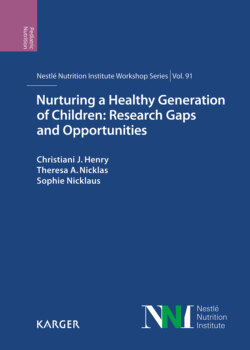Читать книгу Nurturing a Healthy Generation of Children: Research Gaps and Opportunities - Группа авторов - Страница 31
На сайте Литреса книга снята с продажи.
Discussion and Conclusion
ОглавлениеThe prevalence of childhood obesity is rising, and multiple studies indicate that most of the risk factors develop during the early phases of life. These factors may range from the prenatal to the postnatal period. This brief review shows the importance of complementary feeding as a window of opportunity for the development of eating behaviors that can be maintained throughout childhood. The complementary feeding period is a “window of opportunity” to familiarize infants with a wide variety of foods because at this stage infants’ openness to trying new foods is at its peak, and familiar foods are likely to become preferred foods, and these acquired preferences tend to persist in later childhood.
Many children do not eat the currently recommended amounts of vegetables, and parents are frequently searching for practical ways to increase vegetable acceptance. The lack of the sweet flavor and the low energy density of many vegetables and some fruits mean that these foods may be rejected by children, and extra efforts may need to be put in place to help them accept these foods. Within this context, strategies to successfully promote better acceptance of vegetables should be identified. In spite of a huge body of literature, practical aspects and the results of their application are still poorly understood. This is due to the high complexity related to physiological mechanisms underlying early sensory experiences and the development of sensory preferences.
This review shows the effectiveness of breastfeeding, early experiences with vegetable variety during complementary feeding, and repeated experience with an initially disliked vegetable in promoting vegetable acceptance into childhood. The effects are long-lasting and provide the foundation for evidence-based recommendations to help parents promote healthy eating habits to their children. Current infant feeding guidance and practices suggest that this type of approach is not typical in many countries and that there is scope to provide parents and health care professionals with practical advice on encouraging vegetable acceptance during complementary feeding. The findings addressed in this review should be used in the design of future interventions targeting the prevention of childhood obesity.
